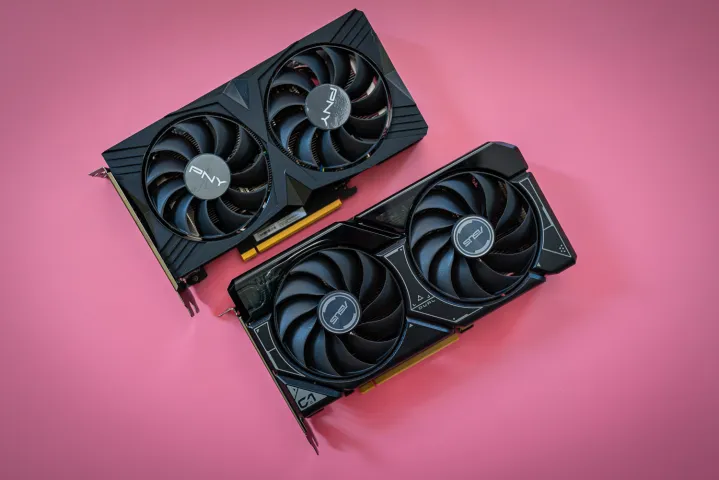Intel just released on of the graphics card can you buy it – the Arc B570 as you can read in my intel Arc B570 reviews it delivers solid gaming Performance. at 1080p, at a cost price we haven’t seen in year. but it face some stiff competition form Nvidia’s in the form of the RTX 4060.

I am put the two budget GPUs on the test bench to see how they hold up in a variety of games and I walk you through in the result I gathered, although both cards are excellent option under $300, Intel new Arc B570 is hard to argue with considering how much less expensive it is than the Nvidia’s competition.
Specs and pricing

Price is the names of games when looking at the Arc B570 against the RTX 4060. The Arc B570 clocks at just $220, while in the Nvidia’s RTX 4060 is $300. That is a pretty significant gap increase in the price which would normally indicate a large gap Performance.
Specs-wise, there are only three things that are important: power, process, and VRAM — damn you, alliteration. For process, both GPUs use TSMC, but Nvidia uses a slightly smaller node. It’s more efficient, and you can see that play out in the rated power draw. The RTX 4060 sips down 115W while the Arc B570 can climb up to 150W; though both cards still use a single 8-pin power connector.
| Arc B580 | RTX 4060 | |
| Architecture | Battlemage | Ada Lovelace |
| Process node | TSMC N5 | TSMC N4 |
| Ray tracing cores | 20 | 24 (3rd-gen) |
| Tensor/XMX cores | 160 | 96 (4th-gen) |
| Boost clock speed | 2.67GHz | 2.46GHz |
| VRAM | 12GB GDDR6 | 8GB GDDR6 |
| Bus width | 192-bit | 128-bit |
| Total Graphics Power (TGP) | 190W | 115W |
| Price | $249 | $299 |
VRAM marks is a big departure, Although it’s not as significant as a specs would suggest. The Arc B570 comes with 10GB and wider memory bus, while the RTX 4060 comes with 8GB and a thinner bus. Straight win for Intel, I am right? Not exactly. Although the Arc B570 comes with higher capacity, and actually for comes with lower effective bandwidth.
The RTX 4060 include a small pool of L3 cache to improve memory bandwidth. This is what AMD would refer to as an Infinity Cache. The Arc B570 has no such cache, so while Intel’s GPU comes with higher capacity, the RTX 4060 and Arc B570 are large similar when it a comes to the real-world gaming experience. You should treat both as 8GB graphics cards, and the implications that come along with that capacity in demanding games like Indiana Jones and the Great Circle.
That’s where the price of the Arc B570 is a big asset. You’ll need to make compromises in VRAM-heavy games regardless of the GPU you choose out of these two, but those compromises are easier to justify for a $220 graphics card compared to a $300 one.
Gaming performance
Onto a benchmarks. Both the RTX 4060 and Arc B570 are squarely focused on 1080p gaming performance. They are may have enough growth to scale up to 1440p in some lighter titles, but if you want the ideal experience, and a stick with 1080p and a high refresh rate gaming monitor. With either GPU, you’re comfortably getting above 60 frames per second (fps) in most games, short of demanding titles like Black Myth: Wukong that will require some upscaling assistance.
There really isn’t a consistent trend among the games I tested, however. Overall, the RTX 4060 comes out slightly ahead with a 6% lead on average, but remember that it’s also 36% more expensive. From a value standpoint, there’s no doubt that Intel wins this battle with the Arc B570.
Nuance is important here, though. As you can see from games like Call of Duty: Modern Warfare 2, Black Myth: Wukong, and Horizon Zero Dawn Remastered, the Arc B570 inexplicably drops the ball in some games. The RTX 4060 has a couple of those games, too, notably Red Dead Redemption 2 and Returnal, though the drops aren’t as extreme.
The important thing here is that both the RTX 4060 and Arc B570 are reaching playable, and sometimes even great, performance in these demanding games at 1080p, and with maxed-out settings. Passing that bar puts more emphasis on value; in many of these games, spending up for the RTX 4060 won’t lead to a noticeably better experience. There’s one exception to that, however, and it’s Black Myth: Wukong.
This is a good example of a cutting-edge PC experience where Nvidia holds up much better than Intel does. Given the slightly lower performance of the Arc B570, I suspect newer games will push it harder, and you’ll be forced to compromise more quickly than you’ll have to with the RTX 4060. The question of if those compromises are worth an extra $80? Well, I’ll leave that up to you.
Ray tracing performance

Both the RTX 4060 and Arc B570 are capable of playing games with ray tracing, particularly at 1080p with some upscaling assistance. Nvidia usually runs away with ray tracing performance, but that’s actually not the case here. The Arc B570 and RTX 4060 posted almost identical results, short of Returnal, where the Arc B570 actually shot ahead.
Ray tracing is totally on the table for both GPUs, and the Arc B570 holds up really well. However, we’re starting to see more games with full-on path tracing, such as Black Myth: Wukong and Alan Wake 2, and in those titles, Nvidia still holds an edge. In fairness, I don’t think either of these GPUs are great for full path tracing, but you’ll have a better chance at turning up all of the visual bells and whistles on Nvidia’s GPU.
Leave a Reply